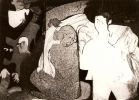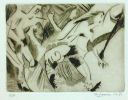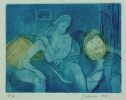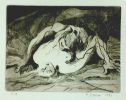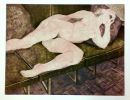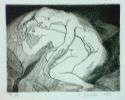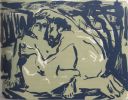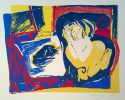Love and Intimacy (1981-1982): Engravings
During these years at the beginning of her artistic maturity, Pilar Lara’s activity is divided into watercolours and graphic work. Some themes are the same, especially erotic themes, but Pilar simultaneously explores the semantic possibilities offered by both techniques to introduce some nuances in her approach. Whereas the love scenes in the watercolours have a more festive, exaggerated, passionate note, in the graphic work these scenes can be quieter- when she uses a simple engraving with burin- or darker, crepuscular, obsessive- when she uses the etching or mezzotint-.
Also, in her graphic work, several nods to her previous stage can be found, since she practices compositions somewhat abstract or of kinetic style. But the most notable and characteristic series is the one containing quiet scenes of couples- on a sofa, on a bench or a boat- or practicing outdoor sports - a series that Pilar significantly titled ‘Seriesport’-. In these works, etching but especially printing with several inks prevail. Pilar was attracted to both the variety of shades offered by this technique on each copy, some intentioned, others unexpected, and to its pictorial qualities. She experienced the forced colour changes in two other works, where she portrays naked women on a sofa. They are a prelude to the themes that she will address in the following stage- which we have called ‘Sueños’ [Dreams]- : melancholic figures in domestic contexts.
Pilar was dedicated to the graphic investigation with passion. She was very interested in the possibility of working on a series of engravings (as she will also do at the end of her last stage, focused on digital works). She started out attending for two years the Antonio Marcoida’s workshops. And also participated in several contests and exhibitions with her engravings: the XIII Certamen Nacional de Pintura de Luarca [13th National Painting Contest of Luarca], the X Premio de Grabado Carmen Arozena [10th Print Award Carmen Arozena] of the Librería Abril [Abril Bookshoop] and the Concurso Calcográfico Nacional [National Hand Engraving Contest] in 1982; the XIII Exposición Nacional de Artes Plásticas de Valdepeñas [13th National Exhibition of Visual Arts of Valdepeñas] in 1983; the I Premio de Grabado del Museo Bello Piñeiro del Ferrol [1st Print Award of the Bello Piñeiro Museum in Ferrol] in 1984; in “Mujeres en el grabado contemporáneo” [Women in Contemporary Printing] at the Centro Cultural Buenavista, and in a collective exhibition that was her first international experience, at the Galeria San Paolo [San Paolo Gallery] in Bologna (Italy) in 1985, two years after her last works on copperplate. Besides, she presented these works together with the watercolours in her first solo exhibition at the Orfila gallery in 1982.
She went back to graphic work in 1985, after attending a summer course taught by Jesús Núñez in Betanzos. Then, she tried screen-printing. The few works she produced using this technique are connected directly with the themes and language used in her contemporary paintings, as expected: nightmares, love scenes between mythic figures and women, and dreamlike transformations. The possibility of using vivid colours and wild strokes offered by screen-printing was an invitation to reflect the expressionist style scenes from canvas to printing. But practice lacked continuity. It did not get past a test: the copies were not even numbered.
She never resumed the other techniques of printing, despite her initial dedication. It was difficult to use the engraving tools due to her dominant hand condition at that time. In addition to this, she had a feeling that the meticulousness and slow pace required by the work on a plate limited her need for the visceral, immediate expression that characterized the following phases of this stage. Therefore, it can be said that she will recover that taste for the slow pace work, like that of a goldsmith, in the fourth stage, although in an entirely different means.


